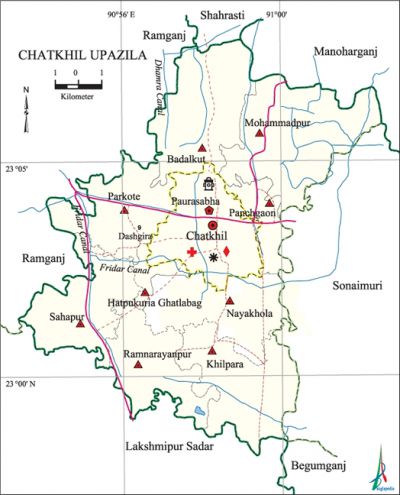Chatkhil Upazila
Chatkhil Upazila (noakhali district) area 133.89 sq km, located in between 22°58' and 23°08' north latitudes and in between 90°53' and 91°02' east longitudes. It is bounded by ramganj, shahrasti and manoharganj upazilas on the north, lakshmipur sadar upazila on the south, sonaimuri upazila on the east, Ramganj and Lakshmipur Sadar upazilas on the west.
Population Total 233253; male 108021, female 125232; Muslim 225701, Hindu 7509, Buddhist 17, Christian 2 and others 24.
Water bodies Fridar canal is notable.
Administration Chatkhil Thana was formed in 1977 and it was turned into an upazila in 1983.
| Upazila | ||||||||
| Municipality | Union | Mouza | Village | Population | Density (per sq km) | Literacy rate (%) | ||
| Urban | Rural | Urban | Rural | |||||
| 1 | 9 | 108 | 129 | 31395 | 201858 | 1742 | 70.1 | 64.9 |
| Municipality | ||||||||
|
Area |
Ward |
Mahalla |
Population |
Density |
Literacy rate (%) | |||
| 13.81 | 9 | 16 | 31395 | 2273 | 70.1 | |||
| Union | ||||
| Name of union and GO code | Area (acre) | Population | Literacy rate (%) | |
| Male | Female | |||
| Khilpara 28 | 3782 | 12132 | 13382 | 62.0 |
| Nayakhola 47 | 3796 | 11276 | 13650 | 68.3 |
| Parkote 66 | 3481 | 11537 | 13343 | 65.2 |
| Panchgaon 57 | 1405 | 5608 | 6535 | 67.4 |
| Badalkut 17 | 4664 | 11947 | 14446 | 65.4 |
| Mohammadpur 38 | 5238 | 16329 | 19226 | 62.8 |
| Ramnarayanpur 76 | 3000 | 10137 | 11880 | 65.0 |
| Sahapur 85 | 2761 | 8467 | 10211 | 66.6 |
| Hatpukuria Ghatlabag 19 | 1546 | 5330 | 6422 | 62.6 |
Source Bangladesh Population Census 2011, Bangladesh Bureau of Statistics.

War of Liberation Most part of the upazila had been almost unreachable because of the extremely bad communication system in and around the area and therefore, the Pak army could not come and establish any camp here during the War of Liberation. Freedom fighters carried out small operations here and there to fight with the razakars. A memorial monument has been built in the compound of the Chatkhil upazila complex.
For details: see চাটখিল উপজেলা, বাংলাদেশ মুক্তিযুদ্ধ জ্ঞানকোষ (Encyclopedia of Bangladesh War of Liberation), বাংলাদেশ এশিয়াটিক সোসাইটি, ঢাকা ২০২০, খণ্ড ৩।
Religious institutions Mosque 288, temple 12. Noted religious institutions: Chatkhil Bazar Mosque.
Literacy rate and educational institutions Average literacy 65.80%; Male 65.17%, female 66.36%. Educational institutions: college 1, secondary school 27, primary school 104, community primary school 8, kindergarten 40, madrasa 19. Noted educational institutions: Chatkhil PG (Panchgaon) Govt. High School (1907), Khilpara Multilateral High School (1914).
Newspapers and periodicals Daily: Chatkhil Barta; weekly: Purbashikha.
Cultural organisations Library 4, club 13, cinema hall 1, playground 12.
Main sources of income Agriculture 29.69%, non-agricultural labourer 2%, industry 0.92%, commerce 14.70%, transport and communication 4.55%, service 16.21%, construction 2%, religious service' 0.48%, rent and remittance 21.29% and others 8.16%.
Ownership of agricultural land Landowner 61.98%, landless 38.02%; agricultural landowner: urban' 57.72% and rural 62.58%.
Main crops Paddy, pulse, betel nut, vegetables.
Extinct or nearly extinct crops Sesame, linseed, mustard, sweet potato, aush paddy.'
Main fruits Mango, jackfruit, banana, papaya, coconut, guava, date.
Fisheries, dairies and poultries This upazila has a number of nursery, dairies and poultries.
Communication facilities Pucca road 284.30 km, semi-pucca road 6.22 km, mud road 527 km.
Extinct or nearly extinct traditional transport Palanquin, bullock cart, horse carriage.
Noted manufactories Rice mill, flour mill, chilli mill, ice factory.
Cottage industries Weaving, blacksmith, potteries, cane work, bamboo work, wood work, metal work.
Hats, bazars and fairs Hats and bazars are 22, fairs 2, most noted of which are Chatkhil, Panchgaon, Dashgharia and Khilpara bazars and Chaitra Sankranti Mela.'
''Main exports Paddy, coconut, betel nut, banana.'
Access to electricity All the wards and unions of the upazila are under rural electrification net-work. However 75.1% of the dwelling households have access to electricity.
Natural resources Natural gas has been discovered in the Saptagaon area of Badalkut union.
Sources of drinking water Tube-well 93.3%, tap 1.2% and others 5.5%. The presence of intolerable level of arsenic has been detected in shallow tube-well water of this upazila.
Sanitation 85.5% of dwelling households of the upazila use sanitary latrines and 11.2% of dwelling households use non-sanitary latrines; 3.3% of households do not have latrine facilities.
Health centres Upazila health complex 1, family planning centre 9, hospital 4.
Natural disasters The floods of 1988, 1998 and the cyclone of 2004 caused heavy damages to settlements livestock and crops of the upazila.
NGO activities Operationally important NGOs are brac, asa, caritas, CARE. [Tawheed Hossain Chowdhury]
References Bangladesh Population Census 2001 and 2011, Bangladesh Bureau of Statistics; Cultural survey report of Chatkhil Upazila 2007.'
